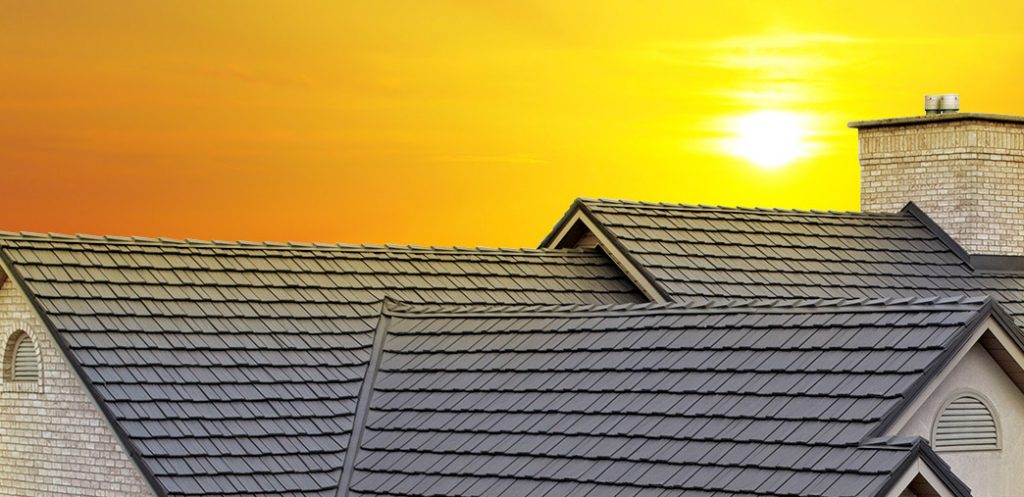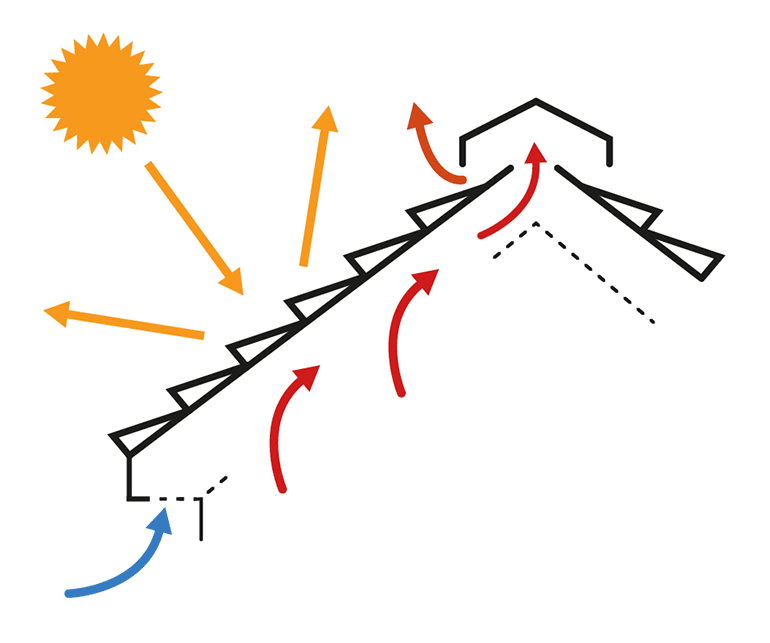Solar Energy and Metal Roofing

On virtually any structure, nothing has more potential to enhance the total building energy efficiency than the roof. And nothing creates a better canvas for energy production than the roof. So, whether it’s saving energy, producing energy, or both, if you’re a property owner looking to roof or re-roof your home or another structure, you must consider how your roofing decision will impact your future energy demand and costs. Failing to do this is short-sighted and will lead to your energy costs being higher than they need to be.
As a manufacturer of metal roofing, Classic Metal Roofing Systems has taken considerable steps to ensure that our products are energy efficient in terms of reducing summer heat gain. A Classic Metal Roof addresses all 3 forms of heat transfer – radiant, conductive, and convective – to achieve a roof system of maximum energy efficiency.
How a Classic Metal Roof Addresses Heat Transfer

- The reflective coatings we use block radiant heat transfer into the attic space. The integral airspace beneath most of our metal roof systems stops conductive heat transfer from the rooftop down into the attic. With proper attic ventilation, convective heat flow in the attic carries any heat that is gained in the attic, back to the outside through a ridge vent or other exhaust vents on the roof.
- While these components and attributes of a Classic Metal Roof save energy through reduced air conditioning demand, we also have engineered methods for attaching solar panels to our roofs for property owners who want to create energy with their rooftops.
- The ultimate, of course, is a roof that produces energy on its own. Over the years, we have seen many companies attempt to integrate energy production with various roofing shingles or other materials. While this is indeed a great idea – one product that serves both as a roof and an energy producer – most of these attempts have failed outright and those that have not outright failed just limp along as costly, inefficient energy producers. However, we think there is a bright future for integrated solar and we’re working on new technology for that purpose.
Solar Shingles?
You may have seen information in the news recently about “solar shingles” and “solar roofing”. We love this concept in that, rather than have your solar investment mounted on top of your roof investment, the solar portion of your roof will actually replace the standard roof. This will effectively reduce the cost of your solar investment because the metal roof will not be installed where the solar is installed.
There are many companies developing and perfecting “solar shingle” technology with whom we are connected. We are seeking the best possible option to bring our customers in terms of solar technology and efficiency and also weathertight integration with our high-quality metal roof systems. Combining solar roofing with metal roofing, and doing it in a way whereby the solar can be updated with future technological advancements is a great way to ensure the ongoing protection and value of your overall roof and solar investment.
Cost-Effective Solar Energy
The current reality is that traditional crystalline photovoltaic panels offer the most cost-effective solar energy production. Their modular nature is very helpful in allowing repairs and replacement. Additionally, while they are durable and built to last 20 or so years, they do eventually need to be replaced, allowing property owners to step up to even more efficient energy production at that time.
Solar Installation on a Classic Metal Roof
Traditional solar panels can be integrated nicely with our metal roofs. With clip-fastened standing seam roofs, the panels can be clamped onto the raised seams so that no or very few actual roof penetrations are necessary. With other types of metal roofs, penetrations of the roof will be necessary but there are many commercially available fastening brackets designed for water tightness that work very well.
Metal roofs are ideal for solar installation. The durability of the metal roof will hold up to roof traffic when the solar array is installed and serviced. The metal roof will also easily last as long as the solar panels themselves. Additionally, cool metal roofs can help to increase the efficiency of solar panels. And, finally, using a metal roof to save energy while producing energy at the same time with solar, is the best of both worlds. Reducing your energy needs with the right roof may reduce the size of the solar array required for your home.
If you consider solar for your home, keep in mind that solar experts generally say their components have a life expectancy of around 20 years. By the end of that time, the production efficiency will have declined and it will be time to update the solar array. However, a quality metal roof will easily last 50+ years so it’s important to make sure that replacing the solar will not require replacing the roof.
Plan for Your Future Energy Needs
If you as a homeowner have plans for solar in the future, discuss those plans with your roofing contractor the next time you roof your home. Depending upon the type of roof you choose to have installed, it may be possible for the installer to take steps now that will simplify solar installation in the future.
What Will the Future Bring to Your Roof?
While our current recommendation is to stick to the tried and true traditional photovoltaic panels, we see integrated solar roofing on the horizon. We believe that the coatings on metal roofs themselves will be suitable solar collectors at some point in the future. This truly will be a fully integrated solar roof that makes sense.
Dreaming of Solar or a Solar Roof?
We’d appreciate the opportunity to talk with you about the solar and roof dreams you have for your home, and determine how we can make those dreams a reality for you.
You can learn more about the energy efficiency of a Classic Metal Roof. Our own roofing guru, Todd Miller, is also available to answer your questions on energy efficiency, roof-top energy production on a metal roof, and more.

